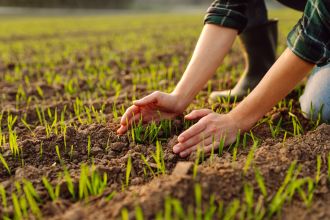
Researchers in Australia have developed a groundbreaking method to enhance photosynthesis in crops, potentially increasing yields of vital staples like wheat and rice while significantly reducing water and nitrogen usage. The project, led by Associate Professor Yu Heng Lau from the University of Sydney and Professor Spencer Whitney from the Australian National University, involves the creation of nanoscale compartments designed to optimize the efficiency of the enzyme Rubisco, a crucial player in the carbon fixation process.
The team’s findings, published in Nature Communications, address a long-standing challenge in agriculture: improving the efficiency of plants in converting carbon dioxide into energy. Lead researcher Dr. Taylor Szyszka explained that despite Rubisco’s importance, it is notoriously inefficient. “Rubisco is very slow and can mistakenly react with oxygen instead of CO2,” she noted. This inefficiency leads to significant energy and resource waste, compelling plants to produce Rubisco in excess—sometimes comprising up to 50 percent of soluble protein in some leaves.
To tackle this issue, the researchers looked to nature for solutions. Certain organisms, such as algae and cyanobacteria, have evolved specialized compartments that house Rubisco and facilitate the concentration of carbon dioxide, leading to more efficient enzymatic reactions. These compartments, known as carboxysomes, have proven difficult to replicate in crops due to their structural complexity and the requirement for multiple genes to function properly.
Instead, Lau and Whitney’s team opted for a simpler solution by utilizing encapsulins—bacterial protein cages that can be constructed from a single gene. This approach allows for a more straightforward assembly process, likened to using Lego blocks. The researchers attached a short “address tag” of 14 amino acids to Rubisco, guiding it to its designated location within the encapsulin.
The team conducted experiments with three different Rubisco varieties—one from a plant and two from bacteria—and discovered that timing in the assembly process is critical. “Rubisco didn’t assemble properly when trying to do both at once,” explained Davin Wijaya, a PhD candidate at the Australian National University who co-led the study.
Dr. Szyszka highlighted another benefit of the encapsulin system: its modular nature. Unlike carboxysomes, which can only accommodate their native Rubisco, the encapsulin system is versatile enough to package various types of Rubisco. “Most excitingly, we found that the pores in the encapsulin shell allow for the entry and exit of Rubisco’s substrate and products,” she said.
While this research marks a promising proof of concept, the team acknowledges that additional components are needed to create the optimal environment for Rubisco’s performance. Early-stage plant experiments are already underway at the Australian National University, with Wijaya reporting, “We know we can produce encapsulins in bacteria or yeast; making them in plants is the next sensible step. Our preliminary results look promising.”
If successful, this innovative technology could provide crops with enhanced carbon-fixing capabilities, leading to higher yields while utilizing less water and nitrogen fertilizer. Given the pressures of climate change and growing populations on global food systems, such advancements could be crucial in ensuring food security moving forward.
The research was supported by the Australian Research Council, and the authors declare no competing interests. The study emphasizes the potential of synthetic biology to contribute to sustainable agricultural practices and improve food production efficiency in an era where resources are becoming increasingly strained.





